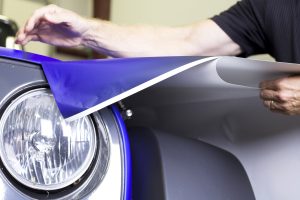Release Liners carry self-adhesive products
Release Liners are an essential part of any self-adhesive product, of which the most well-known are self-adhesive labels, as you find on bags, bottles, boxes, etc . Before applying a label on such an item it is handled on a special carrier, the Release Liner. This Release Liner protects, carries, allows handling of and finally releases the label’s adhesive surface.

In its most often used form a Release Liner comprises a paper with a silicone coating on top of it.
The silicone is a special polymeric material that provides, among its many other properties, the feature that nothing sticks to it [link to silicone page]. This makes it an ideal base for anything sticky like the adhesive of a label. The label, coated on its underside with adhesive, can easily be taken from the silicone surface of the Release Liner and applied to bags, bottles, boxes, etc.
The substrate carrying the silicone polymer is in most cases a paper that has special properties enabling it to become siliconised; there is a variety of papers available for this purpose. Beside paper there are also other substrates that are used as Release Liners, as there are films, polyethylene coated papers, nonwovens, or even metal foils. Not all papers or other substrates can simply become a Release Liner – they always have to be carefully selected to be siliconisable and serve as a Release Liner.
These choices of course also depend on the end user requirements like tensile strength, surface smoothness or roughness, stiffness or flexibility, dimensional stability, and last but not least the release property.

Release value is the essential property of a Release Liner, as its main purpose is to release the sticky material (adhesive) from its surface, after having protected it through all handling and converting operations. This property is measured as the force to remove a certain test tape with a reference adhesive from the silicone surface under controlled conditions. This force is often very low, around 10 cN/25mm (or 10 g/inch) and it can be adjusted. Release is modified not only by one kind of silicone; chemistry provides us with the many different types for the many different adhesives applied by a multitude of end-uses.
The end uses are, e.g. (this list is not exhaustive, but just giving some examples):
- Labels of all kinds (carriers of information)
- Graphic Art products for advertising, decoration, or as traffic signs
- Tapes (double sided tapes mainly require both side siliconised Release Liners)
- Hygiene applications like sanitary napkins
- Medical uses like plasters, transdermal drug systems, and others
- Industrial uses often include other sticky materials like bitumen, butyl rubbers, resins.
- Envelopes
- Baking paper or packaging material for sticky food
IRLA is the industry organisation of companies producing paper-based Release Liners. The IRLA member companies will be happy to assist anyone making the proper choice of a Release Liner for the protection, carrying and finally release of an adhesive product.
 Photo Courtesy of The Dow Chemical Company
Photo Courtesy of The Dow Chemical Company
